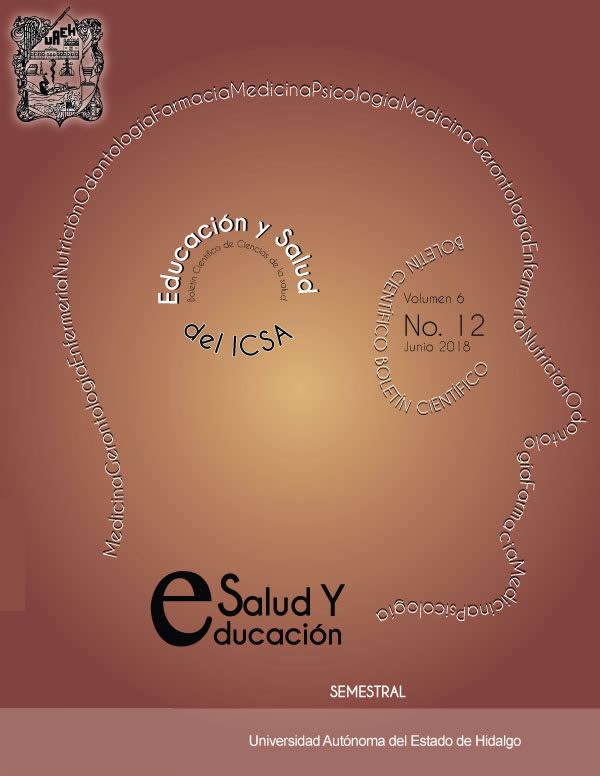Insatisfacción corporal y conductas alimentarias de riesgo como factores determinantes en el desarrollo de trastornos alimentarios y de la ingesta de alimentos
Keywords:
Body Dissatisfaction, Risk Behaviors Eating, Eating Disorders
Abstract
Body Dissatisfaction occurs when the value judgments they have on the body do not coincide with reality. On the other hand, among the main methods for the control of weight and of the corporal figure, is the realization of Risk Behaviors Eating, that carry different behaviors harmful and harmful to the health of the individual. Both factors are key in the origin and development of Eating Disorders. Therefore, the objective of this essay is to explain the relationship between Body Dissatisfaction and Eating Risk Behaviors as determinant variables in the process of developing an Eating Disorder.
Downloads
Download data is not yet available.
References
[1] Espósito DH. Influence of prevalent aesthetic body model and body dissatisfaction in high school students 2015;6:91–6.
[2] Cortez D, Gallegos M, Jiménez T, Martínez P, Saravia S, Cruzat-mandich C, et al. Influence of sociocultural factors on body image from the perspective of adolescent girls. Rev Mex Trastor Aliment 2016;7:116–24. doi:10.1016/j.rmta.2016.05.001.
[3] Valdez-hernández V, Bojorquez I, Lourdes L De, Romo E, Unikel C. “‘ You have to be slim !’” Epiphanies : Body image construction in middle-aged women. Rev Mex Trastor Aliment 2017;8:63–71. doi:10.1016/j.rmta.2017.01.003.
[4] Andreea-elena MĠ. The risk of eating disorders in adolescence and its association with the value of the body mass index , level of anxiety and level of depression 2015;187:141–6. doi:10.1016/j.sbspro.2015.03.027.
[5] Stice E, Marti CN, Durant S. Behaviour Research and Therapy Risk factors for onset of eating disorders : Evidence of multiple risk pathways from an 8-year prospective study. Behav Res Ther 2011;49:622–7. doi:10.1016/j.brat.2011.06.009.
[6] Berengüí R, Castejón MÁ, Soledad M. Body dissatisfaction , risk behaviors and eating disorders in university students. Rev Mex Trastor Aliment 2016;7:1–8. doi:10.1016/j.rmta.2016.02.004.
[7] Betzaida M, Vizmanos B UC. Continuo de conductas alimentarias de riesgo en adolescentes de México. Rev Panam Salud Pública 2011;30:401–7.
[8] Revisión N, Ojeda GA. Trastorno de la Conducta Alimentaria: Anorexia Nerviosa. Revisión bibliográfica. 2006;156:24–30.
[9] Arévalo RV, Aguilar XL, Tellez-girón MTO, Mancilla-diaz JM, Los D. Eating disorders diagnostic : from the DSM-IV to DSM-5 2015:108–20.
[10] Acevedo SP, Saldaña RG, Hernández RL. A preliminary study of the predictive factors of binge eating behavior in three cultures: Mexico, Spain and Argentina. Rev Mex Trastor Aliment / Mex J Eat Disord 2013;4:68–78. doi:10.1016/S2007-1523(13)71994-3.
[2] Cortez D, Gallegos M, Jiménez T, Martínez P, Saravia S, Cruzat-mandich C, et al. Influence of sociocultural factors on body image from the perspective of adolescent girls. Rev Mex Trastor Aliment 2016;7:116–24. doi:10.1016/j.rmta.2016.05.001.
[3] Valdez-hernández V, Bojorquez I, Lourdes L De, Romo E, Unikel C. “‘ You have to be slim !’” Epiphanies : Body image construction in middle-aged women. Rev Mex Trastor Aliment 2017;8:63–71. doi:10.1016/j.rmta.2017.01.003.
[4] Andreea-elena MĠ. The risk of eating disorders in adolescence and its association with the value of the body mass index , level of anxiety and level of depression 2015;187:141–6. doi:10.1016/j.sbspro.2015.03.027.
[5] Stice E, Marti CN, Durant S. Behaviour Research and Therapy Risk factors for onset of eating disorders : Evidence of multiple risk pathways from an 8-year prospective study. Behav Res Ther 2011;49:622–7. doi:10.1016/j.brat.2011.06.009.
[6] Berengüí R, Castejón MÁ, Soledad M. Body dissatisfaction , risk behaviors and eating disorders in university students. Rev Mex Trastor Aliment 2016;7:1–8. doi:10.1016/j.rmta.2016.02.004.
[7] Betzaida M, Vizmanos B UC. Continuo de conductas alimentarias de riesgo en adolescentes de México. Rev Panam Salud Pública 2011;30:401–7.
[8] Revisión N, Ojeda GA. Trastorno de la Conducta Alimentaria: Anorexia Nerviosa. Revisión bibliográfica. 2006;156:24–30.
[9] Arévalo RV, Aguilar XL, Tellez-girón MTO, Mancilla-diaz JM, Los D. Eating disorders diagnostic : from the DSM-IV to DSM-5 2015:108–20.
[10] Acevedo SP, Saldaña RG, Hernández RL. A preliminary study of the predictive factors of binge eating behavior in three cultures: Mexico, Spain and Argentina. Rev Mex Trastor Aliment / Mex J Eat Disord 2013;4:68–78. doi:10.1016/S2007-1523(13)71994-3.
Published
2018-06-05
How to Cite
Onofre-Pérez, E., & RME, G.-S. (2018). Insatisfacción corporal y conductas alimentarias de riesgo como factores determinantes en el desarrollo de trastornos alimentarios y de la ingesta de alimentos. Educación Y Salud Boletín Científico Instituto De Ciencias De La Salud Universidad Autónoma Del Estado De Hidalgo, 6(12). https://doi.org/10.29057/icsa.v6i12.3103
Section
Papers












